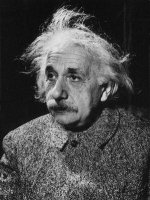I was laying awake the other night pondering many things: Barbecue, the zombie apocalypse, Kentucky basketball, etc. and about 2:00 a.m. I started thinking about the physics of stop shots, so this maybe ought to be addressed to Dr. Dave or someone of his ilk. Here is my question:
Obviously, when a sliding cue ball hits an object ball of equal weight straight on, the cue ball comes to a dead stop and the object moves forward. A classic stop shot. It's maybe the most fundamental shot in pool and there is no question about what happens. My question is why does that happen? With two balls of equal mass, all of the energy is transferred from the moving ball to the stationary ball but why do (if you can put it this way) the laws of physics mandate that with both balls being of equal mass, it is the stationary ball that moves and the cue ball which comes to a halt. It seems that it would be just as reasonable (not that nature ever asked me) for the object ball to remain stationary and the cue ball to bounce straight backwards or maybe for the object ball to pick up half the velocity and the cue ball to lose half so that both are now travelling directly away from each other at half the cue ball's original speed. These sorts of issues keep a guy awake at 2:00 a.m.
There's got to be an answer that a very mathematically challenged English major could understand.
Any help?
Obviously, when a sliding cue ball hits an object ball of equal weight straight on, the cue ball comes to a dead stop and the object moves forward. A classic stop shot. It's maybe the most fundamental shot in pool and there is no question about what happens. My question is why does that happen? With two balls of equal mass, all of the energy is transferred from the moving ball to the stationary ball but why do (if you can put it this way) the laws of physics mandate that with both balls being of equal mass, it is the stationary ball that moves and the cue ball which comes to a halt. It seems that it would be just as reasonable (not that nature ever asked me) for the object ball to remain stationary and the cue ball to bounce straight backwards or maybe for the object ball to pick up half the velocity and the cue ball to lose half so that both are now travelling directly away from each other at half the cue ball's original speed. These sorts of issues keep a guy awake at 2:00 a.m.
There's got to be an answer that a very mathematically challenged English major could understand.
Any help?
